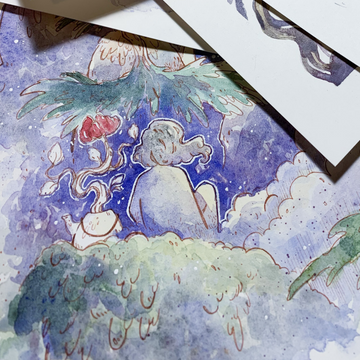In part one of this series, we began exploring ways for artists to comprehensively tell a story visually.
We know, more or less, how to tell a story with words, but how do we translate those stories into visual terms?
In the last article, we established our visual stories must be told well and discussed the elements of visual storytelling.
We took a look at the ways these elements help us visually convey what is happening to the subject of our work.
But there is more to visual storytelling than adding a few elements to our story. There are also helpful rules that allow us to tell our stories with absolute clarity.
The Rules of Visual Storytelling
The best essays are structured perfectly: introduction and thesis; body and supporting arguments; and then the conclusion.
Carefully following these rules for essay writing is the easiest formula for churning out the perfect, concise essay.
These rules don’t hinder creativity, our writing, or the supporting arguments we make to support our thesis. They are helpful and allow us to structure our thoughts and ideas in a way that makes sense to audiences.
Think of the rules of visual storytelling in the same way. Sometimes, rules can be broken for the sake of creativity (and that’s great!), but more often than not, these rules aren’t there to inhibit us and our creative vision.
They’re there to help guide the direction that we’re taking our visual stories. 
Here are a few of those rules:
Every Object Must Have a Purpose—This might sound odd, but sometimes when we’re new to drawing and painting, it can be a temptation to add a lot of things that might look cool. But do they add to the story?
Sometimes something that looks really cool in a painting might actually be distracting to the story that we’re trying to tell.
Make sure that every object included in your visual story has a purpose. It should drive your story forward.
Maybe audiences won’t understand how every little thing is adding to the story, but it will still be a stronger visual story if you know how the objects tell your story.
These objects can be anything from the band-aids on a character’s knees, autumn leaves drifting in the wind, props, background elements, extraordinary creatures—absolutely anything.
All of these things come together to tell the story that we are showing the world through our art. We only have to make sure that it is helping the story we’re telling.
Don’t Clutter the Visual Field— This rule is an important follow up to the previous rule. Even though every object must have a purpose, there is just the chance that we can be adding too many things to our artwork.
The danger is that by adding too many elements to the story, the focal point and subject of the painting become lost in the chaos.
If there are too many things going on, fighting to tell the story the danger is that the main character “can’t be heard” anymore.
Find the right balance of elements to add to the story, and always keep your focal point prominent.

Don’t Skimp on the Appropriate Details— The rule for not cluttering our artwork isn’t a free pass to skip the appropriate amount of work necessary. The appropriate amount of details is just as important as not cluttering it.
If we can overwhelm the viewer with too many details, then we can certainly underwhelm them with not enough.
The risk of not adding enough to our visual stories is that a large part of the story we are trying to tell remains unclear.
Clarity—every object, action, emotion, and the setting should be rendered clearly in the work. Take the appropriate time to make sure that audiences can look at the work and understand what is happening.
This can be anything from the way a scene is set up and painted, composition, to rendering individual objects. Bring clarity to the way everything in the painting relates to everything else.
The emotion of the subject has to relate logically to the setting, action, and what is taking place. Everything taking place has to relate to the emotion and mood.
This brings clarity to our audiences. If they don’t have to wonder what we’re painting for them, the better our work is!

Colour Pallets & Lighting
The rules above apply to tangible objects that we paint and illustrate, but now we’ll move on to illusions that we create in our painting process: such as lighting and colour pallets.
The colour palettes and lighting that we choose for our paintings play into the stories that we are telling. Colour palettes can be carefully selected to further the story you’re telling.
Colour pallets tend to be selective in the colours that they choose to add or detract from a piece. It affects the mood and it reflects the emotion of the story. Use this to your advantage!
There’s a psychologically emotional aspect to colour, and we can use that to benefit the stories we’re painting. If our subjects are melancholy or joyful, pick the colours that correlate appropriately to those emotions.
Lighting is also an excellent tool for storytelling. It can be used to direct the mood of the piece, but it can also be used to highlight important elements of the story.
Lighting can be used to draw attention to the focal point, or it can be used to highlight important artifacts and props.
Even though these rules and elements of visual storytelling seem like an extensive set of guidelines, their only intent is to narrow the focus of the work that is being created to tell a clearer story.
There is no limit to the elements, colours, props, characters, and moods that can be told—and any combination of these elements, rules, and details are the tools we use to tell stories to the world!


